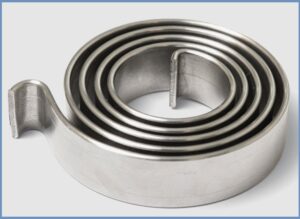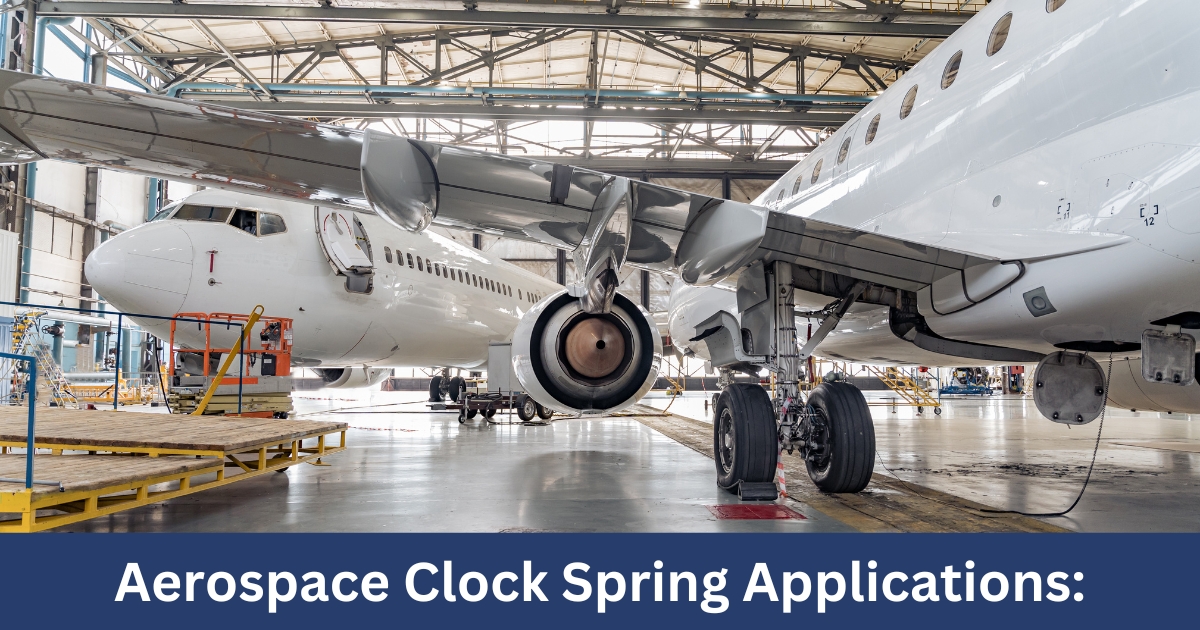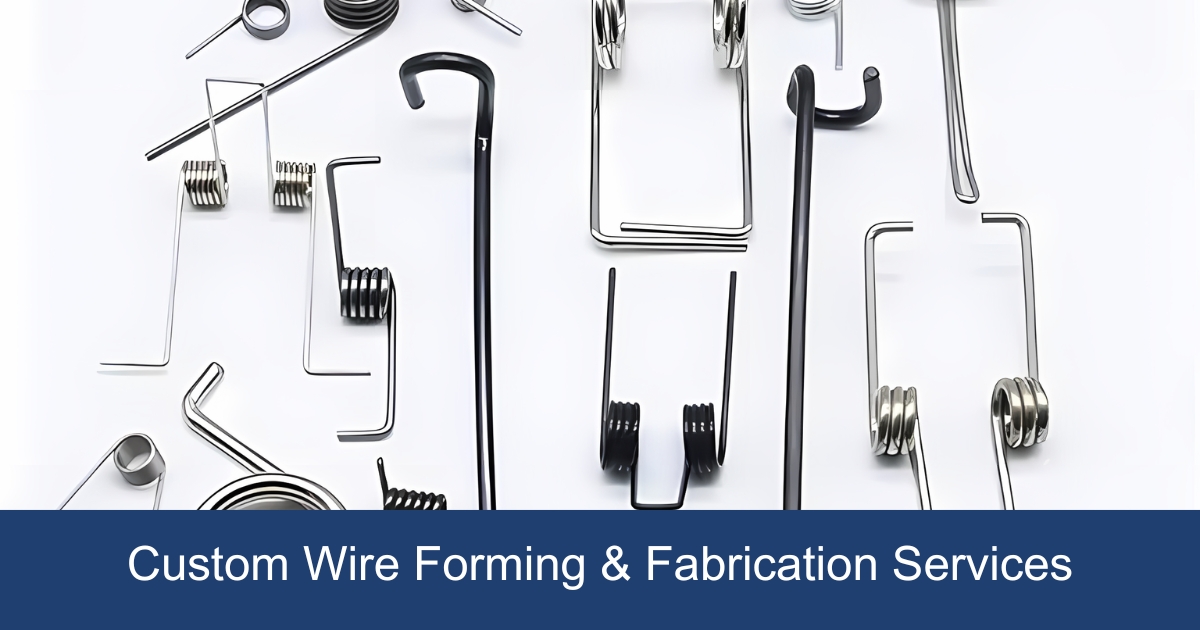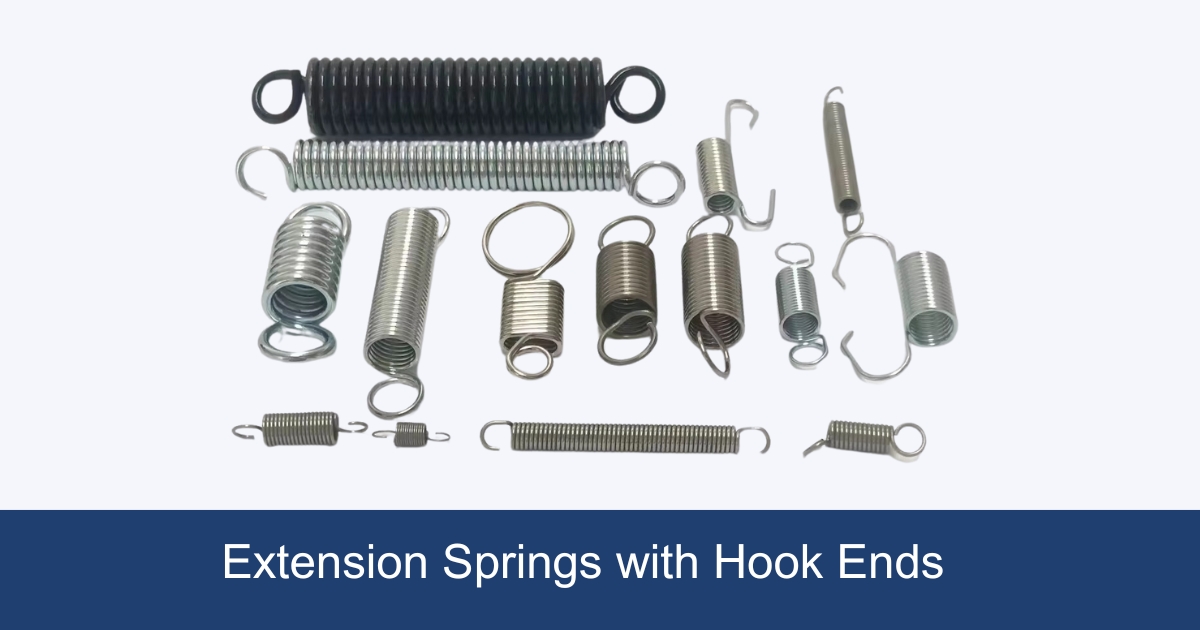Whether you want to find more information about spiral torsion springs like features, application, mounting method, design requirement.
or you are looking for high-quality spiral torsion springs.
everything you’re looking for is right here.
Let dive right in.

What are the spiral torsion springs?
Spiral torsion springs are a type of torsion spring, which is designed to operate with a twist or rotational motion. They are called “spiral” because their coils form a spiral or helix shape. Unlike traditional torsion springs, which typically have a straight coil and are used in applications requiring angular movement, spiral torsion springs are designed to provide torque in a circular motion over many rotations, often more than 360 degrees.
The functionality of a spiral torsion spring comes from its ability to store and release rotational energy. When the spring is twisted, it stores energy; when it is released, it exerts a force in the opposite direction, providing torque to the attached component. This makes them suitable for applications requiring a constant torque over a wide range of motion.
What are the uses of spiral torsion springs?
Spiral torsion springs have a wide range of applications due to their unique ability to provide rotational force or torque over a broad rotational range. Their versatility and efficiency in delivering constant torque make them indispensable in various mechanical and electronic devices. Here are some common uses of spiral torsion springs:
- **Clocks and Watches**: One of the most traditional uses of spiral torsion springs is in mechanical clocks and watches. In these applications, the spring, often called a mainspring, stores energy when wound and releases it gradually to power the movement of the hands.
- **Motors and Starters**: Spiral torsion springs are used in the starting mechanisms of some motors and engines, providing the initial torque needed to start the operation.
- **Industrial Machinery**: They find applications in various industrial machinery and equipment where rotational motion or torque is required, aiding in the functionality of the machinery through controlled movement.
- **Retractable Devices**: Spiral torsion springs are ideal for retractable mechanisms like tape measures, retractable cords, and retractable doors, where they help in winding and unwinding actions.
- **Automotive Components**: In the automotive industry, these springs are used in components like seat recliners, trunk lifts, and window winders, where they facilitate smooth and controlled movement.
- **Consumer Electronics**: Devices such as cameras, where spiral torsion springs might be used to assist in the mechanical movements required for focusing or zooming functions.
- **Medical Devices**: In medical equipment, such as surgical staplers and other devices requiring precise and controlled rotational movements.
- **Aerospace and Defense**: In aerospace and defense, spiral torsion springs are used in mechanisms requiring high precision and reliability under extreme conditions.
- **Office Equipment**: In office appliances like photocopiers and printers, where they contribute to the paper feeding and handling mechanisms.
The design and material selection for spiral torsion springs are critical and depend on the specific application, including the required torque, operational environment, and expected lifecycle. Their ability to provide a consistent torque over a wide range of motion makes them an essential component in many mechanical systems.
How does a spiral torsion springs work?
Spiral torsion springs work by storing rotational energy when they are twisted. This type of spring is designed to exert torque in a rotational manner, meaning it applies force in a circular direction. The basic principle behind how they work involves the material’s elasticity and its ability to return to its original shape after being deformed. Here’s a closer look at the mechanics:
- **Energy Storage**: When a spiral torsion spring is twisted, it stores mechanical energy. This is due to the material’s resistance to twisting, which is a property known as the modulus of elasticity. The energy is stored in the form of potential energy within the spring’s material.
- **Exerting Torque**: Once the spring is twisted and the force is released, the spring naturally wants to return to its original, untwisted position. As it does so, it releases the stored energy, exerting a force known as torque. Torque is a measure of the rotational force applied.
- **Controlled Release of Energy**: The unique design of spiral torsion springs allows for a controlled release of this stored energy over a wide range of motion. Unlike coil springs, which typically operate over a small angle of rotation, spiral torsion springs can provide a consistent torque over many rotations. This makes them particularly useful in applications requiring rotational movement or the controlled release of energy over an extended period.
What material is used to make spiral torsion springs?
Spiral torsion springs can be made from a variety of materials, each selected based on the specific requirements of the application, including the required force, environmental conditions, and cost. The choice of material affects the spring’s performance, durability, and resistance to various stresses such as corrosion, temperature, or wear. Here are some of the most common materials used to manufacture spiral torsion springs:
### 1. **High-Carbon Steel**
– High-carbon steel is a popular choice for springs due to its high tensile strength and hardness. It is suitable for applications requiring high force and durability. However, it may require protective coatings to prevent rust.
### 2. **Stainless Steel**
– Stainless steel is used for its corrosion resistance and good mechanical properties. It’s ideal for springs used in harsh environments or in applications where rust could be a concern, such as in medical devices or outdoor machinery.
### 3. **Spring Steel**
– Spring steel is a specific category of carbon steel with characteristics optimized for spring applications, including elasticity and return to its original shape after deformation. It combines strength with flexibility, making it a common choice for many types of springs.
### 4. **Beryllium Copper**
– Beryllium copper is used in applications requiring electrical conductivity or where non-magnetic materials are necessary. It offers good corrosion resistance and is suitable for environments with temperature fluctuations.
### 5. **Phosphor Bronze**
– This alloy is known for its excellent fatigue resistance and is used in electrical applications and in environments where corrosion resistance and resilience are important.
### 6. **Inconel**
– Inconel alloys are used for springs that must withstand extreme temperatures and corrosive environments. They are particularly suited for aerospace, chemical, and nuclear applications.
### 7. **Elgiloy**
– Elgiloy is a cobalt-chromium-nickel alloy known for its high strength, excellent corrosion resistance, and stability across temperature variations. It’s used in demanding applications, such as in the aerospace and medical industries.
### 8. **Titanium**
– Titanium is chosen for its high strength-to-weight ratio, corrosion resistance, and non-magnetic properties. It’s used in applications where weight is a critical factor, such as in aerospace and sporting goods.
The selection of material for a spiral torsion spring depends on a balance between performance requirements and cost considerations. Environmental factors like temperature, humidity, and exposure to chemicals or saltwater can also influence material choice, as can the need for specific properties like conductivity or non-magnetic characteristics. Custom springs may require specialized materials to meet unique application demands.
How to design spiral torsion springs?
Designing spiral torsion springs involves a detailed process to ensure the springs meet the specific needs of your application. Here’s a guide to both designing spiral torsion springs:
### Designing Spiral Torsion Springs
- **Define the Application Requirements**: Identify the purpose of the spring, including the torque requirements, rotational deflection, and the environment in which the spring will operate. Consider factors such as temperature, potential for corrosion, and required lifespan.
- **Select Material**: Based on the application requirements, choose a material that offers the best combination of strength, flexibility, and durability. Common materials include high-carbon steel, stainless steel, and specialty alloys for more demanding applications.
- **Determine the Dimensions**: Calculate the optimal dimensions for the spring, including the inner and outer diameter, thickness of the material, and the length of the spring when fully extended. The design should also specify the number of turns or coils necessary to achieve the desired torque and rotational deflection.
- **Consider the Mounting Method**: The design of the spring should include how it will be mounted in the application, including any necessary fixtures or attachments. This influences the end design of the spring, such as the shape of the ends or the inclusion of tabs or holes for mounting.
- **Prototype and Test**: Before finalizing the design, produce a prototype spring and test it in the intended application. This step can help identify any necessary adjustments to the design or material selection.
Spiral torsion springs price?
The price of spiral torsion springs can vary widely based on several factors such as material type, size, complexity of the design, quantity ordered, and the specific requirements of the application. Given these variables, here are some general guidelines:
- **Material Type**: The choice of material, which could range from stainless steel to high-carbon steel or even exotic alloys, affects the price significantly. Materials with higher durability, corrosion resistance, or specific performance characteristics typically cost more.
- **Size and Complexity**: Larger springs or those with complex designs require more material and more intricate manufacturing processes, leading to higher costs.
- **Quantity**: Ordering in bulk often reduces the cost per unit due to economies of scale. Manufacturers may offer discounts for large orders.
- **Customization**: Custom-designed springs, tailored to specific applications, can be more expensive than standard off-the-shelf springs due to the additional engineering and tooling required.
- **Manufacturing Precision**: Springs requiring high precision and tight tolerances might need advanced manufacturing techniques, which can increase the cost.
- **Finish and Additional Treatments**: Additional processes such as coating, heat treatment for enhanced performance, or special finishes for corrosion resistance can add to the cost.
For a rough estimate, small, simple spiral torsion springs made from common materials might start at a few dollars each for bulk orders. However, for custom designs, especially those requiring specialized materials or precision manufacturing, the cost can increase significantly, potentially reaching hundreds of dollars per unit for very specialized applications.
It’s best to contact spiral torsion spring manufacturers or suppliers directly with your specific requirements for an accurate quote. Companies like Zigoal, specializing in custom spring manufacturing, can provide detailed pricing based on your specific needs, quantities, and design specifications.



